Gaps in Greenland Ice Sheet
Air Date: Week of March 7, 2025
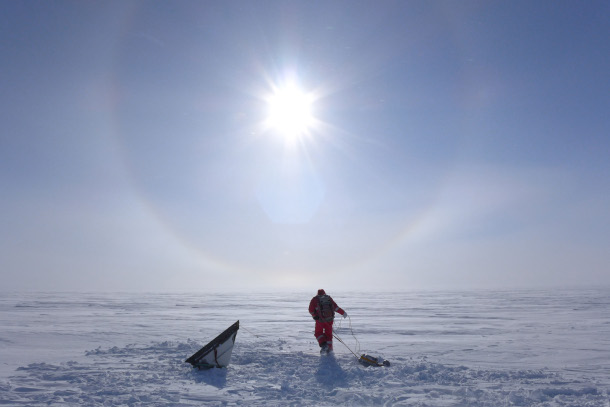
A glaciologist installs radar reflectors in Greenland. Radar reflectors are often used to study the internal structures of ice sheets. (Photo: Silvan Leinss, WikimediaCommons, CC BY-SA 4.0)
A new study shows that crevasses or cracks on the Greenland Ice Sheet are widening more rapidly than expected due to climate change, which may accelerate ice loss and global sea level rise. Lead author Dr. Thomas Chudley, glaciologist and associate professor at Durham University, talks with Host Aynsley O’Neill about the findings of this study and the implications for the future.
Transcript
CURWOOD: It’s Living on Earth, I’m Steve Curwood.
O’NEILL: And I’m Aynsley O’Neill.
The magnificent Greenland Ice Sheet covers about 80% of the island, stretches over 660,000 square miles and reaches depths of up to two miles in places. But this massive block of ice is more fragile than it looks. As the planet rapidly warms, huge cracks are opening up and meltwater is carving down through the ice. Scientists documented the speed at which the Greenland Ice Sheet appears to be falling apart in a study published in Nature Geoscience in February 2025. Lead author Dr. Thomas Chudley is a glaciologist and an assistant professor at Durham University, and he joins me now to explain the findings and what they could mean for planetary sea level rise. Professor Chudley, welcome to Living on Earth!
CHUDLEY: Hi. Thanks for having me.
O'NEILL: So, what did you aim to find out with this study?
CHUDLEY: In this study, we were interested in looking at crevasses, which are cracks in the surface of the ice that are caused by what we call ice dynamics. That's the movement and stresses that appear in the ice. We would have expected crevasses to increase across the ice sheet since the 1990s because the ice sheet has been accelerating into the ocean in response to warmer ocean temperatures. But no one's actually been able to record this or found evidence of it from observational data that's from satellites or in the field, and that's largely because of data limitations. So, for the first time, we hunted through an enormous archive of 3D maps of the surface, and were able to find exactly where crevasses were and how deep they were. We counted them across the entirety of the green dye sheet, between 2016 and 2021 and we were looking at where they changed, how fast and why.
O'NEILL: So, you're talking about the depth of the crevasses. But from an aerial perspective, what would they look like? Are they tiny, or are they massive?
CHUDLEY: So, crevasses can be at all scales. Inland, the ice can be moving very slowly, maybe 10s of centimeters a day to a couple meters a day. And here you might find that crevasses are very small, millimeter size. You could step on them and not notice as the ice begins to speed up, particularly in what we call the marine terminating sectors of the ice sheet. This is fast flowing ice that's flowing into the ocean through fjords. In these sectors, you might begin to see crevasses that are over a meter wide. And here we might need, when we're traveling around, to be roped up with appropriate safety equipment and safety training that allows us to traverse safely. And if we fall down, we can be rescued if we go in. As you begin to get to the very front of these large glaciers that discharge ice into the ocean, you can get crevasses that are 10s of meters wide, up to 100 meters wide. So, you can easily fly a helicopter through some of these. These chasms basically. So, we can see crevasses at all scales.
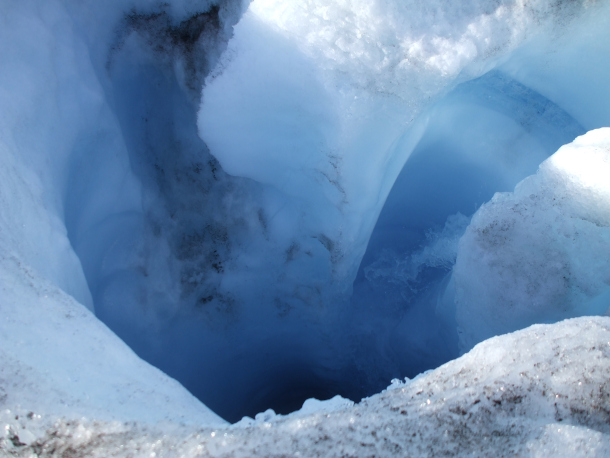
Meltwater rivers may flow down into moulins and reach the base of the ice sheet. (Photo: Halorache, WikimediaCommons, CC BY-SA 3.0)
O'NEILL: And we already understood that the crevices were expanding, but the study found that the crevasses are expanding more quickly than perhaps previously anticipated. So, what's the comparison like between what was thought before and what the study found?
CHUDLEY: So previously, we had sort of no idea how fast crevasses might be changing. So, there were studies in the past that showed that there were in the order of 10 or 15% increases over the scale of decades. And this is the first study that's looked at anything beneath the decadal scale. And we found, over five years, in some sectors of the ice sheet, you're seeing up to an increase of 25% in crevasse volume over the course of these five years.
O’NEILL: So, melting glaciers are part of what is described as a feedback cycle. Can you describe what that feedback cycle is?
CHUDLEY: Nearly every part of the glacier is interconnected, so you can change one part and start to see this domino effect that changes things elsewhere. The thing that we think is causing crevasses to increase is warmer ocean temperatures that eat away for the glacier at the front. As we see these crevasses open, what's really interesting to me, at least, is that they act as a pathway for energy to get into the ice sheet. So rather than just melting from the top as the atmosphere warms, or from the front as the ocean warms, you can start to see melt water, which normally would run off the top of the glacier, actually into the belly of the glacier. And what this can do is it can refreeze and release energy, what we call latent heat, if we can remember that from our high school chemistry classes, or potentially, we can get under the glacier, and it travels along the bed, and there we can lubricate the bed. And I like to think of this like a hovercraft. So, when a hovercraft, you pump air beneath it, it begins to pump up and float along the surface. Well in a glacier, if we pump water beneath them with that, water can't be evacuated. You can also see lower pressures that can increase glacier acceleration, then the water reaches the front. And as it reaches the front of the ice, and it comes up through the fjord, it forms these big plumes. You can see these big kind of areas of dirty water at the front where the ice meets the ocean. And those plumes bring up low-lying warm ocean water from the bottom of the fjord to the top as well. That warm water is escalated at the top of the ice and can accelerate melting. And of course, all the while, these crevasses are fractures that can initiate these huge carving events, so encourage the discharge of ice into the ocean as icebergs as well. So, from cradle to grave, really, we have these interactions that these crevasses can cause that can potentially speed up the discharge of ice into the ocean.
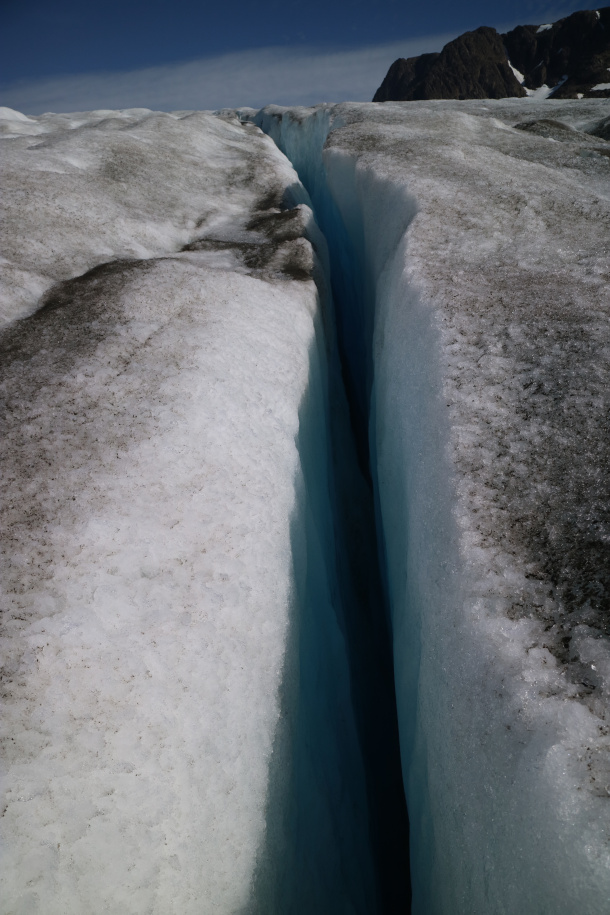
Pictured above is a crevasse of the Mittivakkat glacier in Ammassalik Island, Southeast Greenland. (Photo: Clemens Stockner, Wikimedia Commons, CC BY-SA 4.0)
O'NEILL: Tom, in these glaciers that you've studied, to what extent is their melt contributing to sea level rise?
CHUDLEY: The Greenland Ice Sheet contributes to sea level rise in two ways. And the first way is through melt, like an ice cube would melt, and the second way is through what glaciologists call dynamic loss or discharge, and this is effectively the loss of ice into the ocean as icebergs. Depending on what study you look at, you can get slightly different results. But broadly, we're looking at a 50/50 split between the loss of meltwater from Greenland and the loss of solid ice discharge from Greenland.
O'NEILL: How would you say that studying these crevasses and these glaciers, generally speaking, is going to help us understand what awaits us in the coming years?
CHUDLEY: In order to better prepare for climate change and for sea level rise, specifically, we need accurate projections of what's going to happen and how severe sea level rise will be. Currently, one of the biggest uncertainties in our scientific projections of sea level rise from numerical models are these dynamic instabilities in the Greenland and Antarctic ice sheets. So, by dynamics, I mean the movement of the ice and the discharge of ice into the ocean. Crevasses underpin many of these processes like I've discussed today. And when you look at some of the latest predictions, it could be anywhere between a meter by 2100 and ten meters by 2300 of sea level rise, that is essentially uncertain and may cause because of these dynamic instabilities.
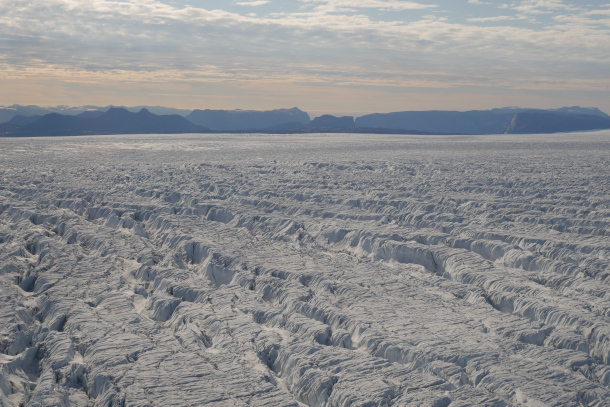
The Greenland ice sheet is the second largest body of ice in the world, and it holds about 2.9 million cubic kilometers of ice. Studying crevasses helps scientists better understand how climate change is impacting ice mass and sea level rise. (Photo: Courtesy of Thomas Chudley)
O'NEILL: We can understand the glacier melt as a concern when it comes to sea level rise and warming climate. But what other kind of significance is there to glaciers and ice sheets? You know, what kind of ecosystem services would you say they provide?
CHUDLEY: So, across the world, there are loads of communities that can rely on glaciers and ice caps in many different ways. They can be important for irrigation, specifically in high altitude deserts like, say, the Himalaya or the Andes. They can be important for water supply, for hydroelectric power generation, for instance, in Switzerland and across the developed world, they're also of economic importance for attracting tourism to places like ski resorts. And in many places, and particularly indigenous cultures, there are of spiritual importance and historical importance of the cultures and communities that live nearby. So, even though to many of us glaciers are quite distant and exotic things, they are critically important to many communities across the world.
O'NEILL: Tom, if we were able to stop greenhouse gas emissions immediately, what chances are there of these glaciers recovering?
CHUDLEY: In glaciology, we talk about committed sea level rise. If we stopped all of our emissions tomorrow, we would probably still see one meter of sea level rise that we have already committed to changing in global glaciers, ice caps and ice sheets, so we would still have to deal with that consequence. As we start to exceed 1.5 degree of warming and reach two degrees or three degrees, we start to trigger more and more of these tipping points, and everyone we cross, it becomes more and more severe and irreversible.
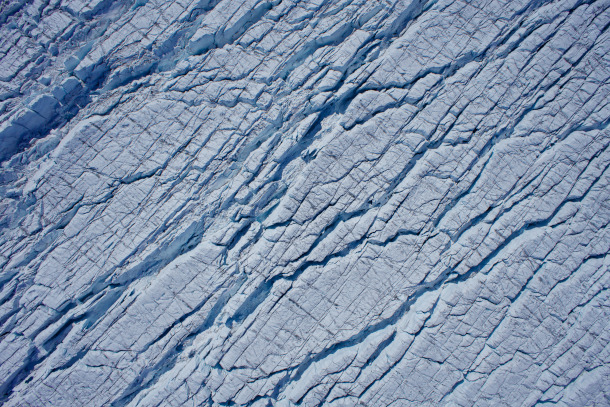
Pictured above is an aerial view of Crevasses in the Greenland Ice Sheet. (Photo: Courtesy of Thomas Chudley)
O'NEILL: And now we talked a little bit about how distant this feels to so many people. You know, how many people have seen a glacier, much less been to one? What's the main point that you'd like to get across to people who might not know anything about this field?
CHUDLEY: So some of these topics that we've discussed today, these dynamic instabilities, if we add them together, across Greenland and Antarctica, and we start to exceed 1.5 or two degrees of sea level rise, we could potentially see a meter of sea level rise by 2100, meters of sea level rise by 2300, 75% of all cities in the world with more than 5 million inhabitants exist beneath 10 meters above sea level. In 2024, we, for the first time had average temperatures higher than 1.5 degrees above preindustrial temperatures. So, we are beginning to enter the 1.5 degree world. If we want to stop that happening, we need to reduce our CO two emissions by 50% by 2030 we need to do this with absolute urgency. Every single degree of global warming matters. Every fraction of a degree of global warming matters.
O'NEILL: So, Tom, what's next for you in this research?
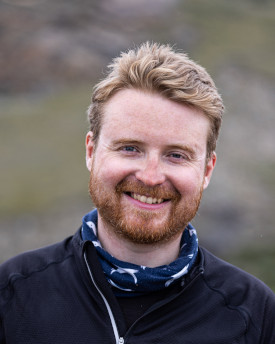
Thomas Chudley is a glaciologist and Assistant Professor in the Department of Geography at Durham University. (Photo: Courtesy of Thomas Chudley)
CHUDLEY: I talked today about a number of different feedbacks that can happen between crevasses and meltwater and the ocean and ice dynamics. And there are plenty of studies that try and address these feedbacks individually. And you can find studies that suggest specific feedbacks might cause 10% of acceleration here or 30% extra loss here. What I think is quite important is that now that we can begin to observe where these crevasses are on an ice sheet scale, we should begin to answer what happens when all these crevasses are working together in a complete system? So, I said the phrase cradle to grave. We need to understand from the cradle to the grave of meltwater and of crevasse life cycle, what are all of these processes doing, and how are they going to impact on sea level rise in the future, and we need to build those into the numerical models that predict the future of ice sheets, like greens and Antarctica and how they're going to impact sea level.
O'NEILL: Tom Chudley is a glaciologist at Durham University. Tom, thank you so much for joining me today.
CHUDLEY: Thanks for having me.
Links
Nature: “Increased Crevassing Across Accelerating Greenland Ice Sheet Margins”
Living on Earth wants to hear from you!
Living on Earth
62 Calef Highway, Suite 212
Lee, NH 03861
Telephone: 617-287-4121
E-mail: comments@loe.org
Newsletter [Click here]
Donate to Living on Earth!
Living on Earth is an independent media program and relies entirely on contributions from listeners and institutions supporting public service. Please donate now to preserve an independent environmental voice.
NewsletterLiving on Earth offers a weekly delivery of the show's rundown to your mailbox. Sign up for our newsletter today!
 Sailors For The Sea: Be the change you want to sea.
Sailors For The Sea: Be the change you want to sea.
 The Grantham Foundation for the Protection of the Environment: Committed to protecting and improving the health of the global environment.
The Grantham Foundation for the Protection of the Environment: Committed to protecting and improving the health of the global environment.
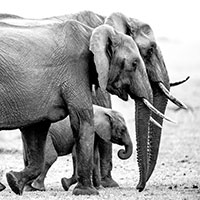 Contribute to Living on Earth and receive, as our gift to you, an archival print of one of Mark Seth Lender's extraordinary wildlife photographs. Follow the link to see Mark's current collection of photographs.
Contribute to Living on Earth and receive, as our gift to you, an archival print of one of Mark Seth Lender's extraordinary wildlife photographs. Follow the link to see Mark's current collection of photographs.
 Buy a signed copy of Mark Seth Lender's book Smeagull the Seagull & support Living on Earth
Buy a signed copy of Mark Seth Lender's book Smeagull the Seagull & support Living on Earth

